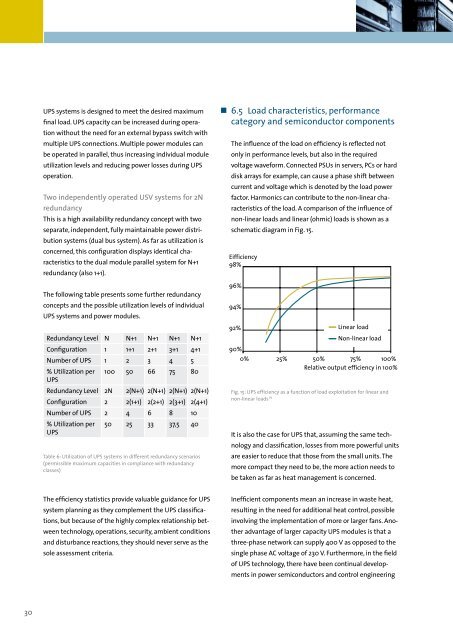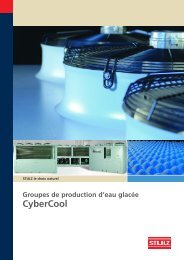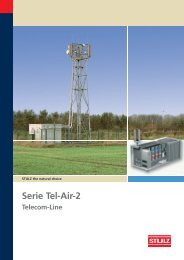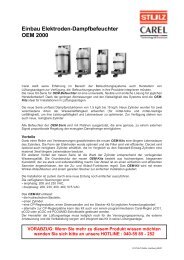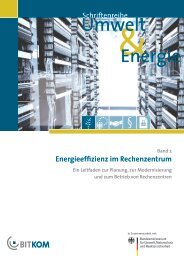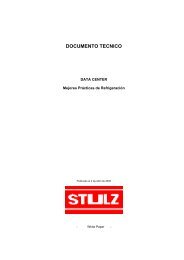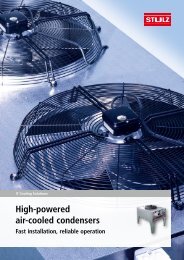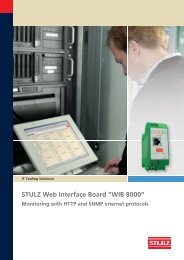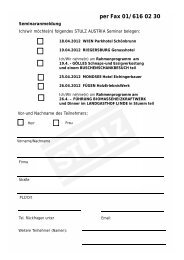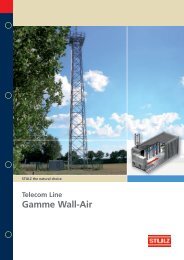Climate protection needs energy efficient data centers - Stulz GmbH
Climate protection needs energy efficient data centers - Stulz GmbH
Climate protection needs energy efficient data centers - Stulz GmbH
Create successful ePaper yourself
Turn your PDF publications into a flip-book with our unique Google optimized e-Paper software.
UPS systems is designed to meet the desired maximumfinal load. UPS capacity can be increased during operationwithout the need for an external bypass switch withmultiple UPS connections. Multiple power modules canbe operated in parallel, thus increasing individual moduleutilization levels and reducing power losses during UPSoperation.Two independently operated USV systems for 2NredundancyThis is a high availability redundancy concept with twoseparate, independent, fully maintainable power distributionsystems (dual bus system). As far as utilization isconcerned, this configuration displays identical characteristicsto the dual module parallel system for N+1redundancy (also 1+1).The following table presents some further redundancyconcepts and the possible utilization levels of individualUPS systems and power modules.Redundancy Level N N+1 N+1 N+1 N+1Configuration 1 1+1 2+1 3+1 4+1Number of UPS 1 2 3 4 5% Utilization per 100 50 66 75 80UPSRedundancy Level 2N 2(N+1) 2(N+1) 2(N+1) 2(N+1)Configuration 2 2(1+1) 2(2+1) 2(3+1) 2(4+1)Number of UPS 2 4 6 8 10% Utilization perUPS50 25 33 37,5 40Table 6: Utilization of UPS systems in different redundancy scenarios(permissible maximum capacities in compliance with redundancyclasses)• 6.5 Load characteristics, performancecategory and semiconductor componentsThe influence of the load on efficiency is reflected notonly in performance levels, but also in the requiredvoltage waveform. Connected PSUs in servers, PCs or harddisk arrays for example, can cause a phase shift betweencurrent and voltage which is denoted by the load powerfactor. Harmonics can contribute to the non-linear characteristicsof the load. A comparison of the influence ofnon-linear loads and linear (ohmic) loads is shown as aschematic diagram in Fig. 15.Eifficiency98%96%94%92%90%Linear loadNon-linear load0% 25% 50% 75% 100%Relative output efficiency in 100%Fig. 15: UPS efficiency as a function of load exploitation for linear andnon-linear loads 18It is also the case for UPS that, assuming the same technologyand classification, losses from more powerful unitsare easier to reduce that those from the small units. Themore compact they need to be, the more action <strong>needs</strong> tobe taken as far as heat management is concerned.The efficiency statistics provide valuable guidance for UPSsystem planning as they complement the UPS classifications,but because of the highly complex relationship betweentechnology, operations, security, ambient conditionsand disturbance reactions, they should never serve as thesole assessment criteria.In<strong>efficient</strong> components mean an increase in waste heat,resulting in the need for additional heat control, possibleinvolving the implementation of more or larger fans. Anotheradvantage of larger capacity UPS modules is that athree-phase network can supply 400 V as opposed to thesingle phase AC voltage of 230 V. Furthermore, in the fieldof UPS technology, there have been continual developmentsin power semiconductors and control engineering30


